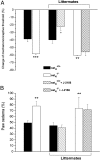Impaired defense mechanism against inflammation, hyperalgesia, and airway hyperreactivity in somatostatin 4 receptor gene-deleted mice
- PMID: 19622729
- PMCID: PMC2722291
- DOI: 10.1073/pnas.0900681106
Impaired defense mechanism against inflammation, hyperalgesia, and airway hyperreactivity in somatostatin 4 receptor gene-deleted mice
Abstract
We have shown that somatostatin released from activated capsaicin-sensitive nociceptive nerve endings during inflammatory processes elicits systemic anti-inflammatory and analgesic effects. With the help of somatostatin receptor subtype 4 gene-deleted mice (sst(4)(-/-)), we provide here several lines of evidence that this receptor has a protective role in a variety of inflammatory disease models; several symptoms are more severe in the sst(4) knockout animals than in their wild-type counterparts. Acute carrageenan-induced paw edema and mechanical hyperalgesia, inflammatory pain in the early phase of adjuvant-evoked chronic arthritis, and oxazolone-induced delayed-type hypersensitivity reaction in the skin are much greater in mice lacking the sst(4) receptor. Airway inflammation and consequent bronchial hyperreactivity elicited by intranasal lipopolysaccharide administration are also markedly enhanced in sst(4) knockouts, including increased perivascular/peribronchial edema, neutrophil/macrophage infiltration, mucus-producing goblet cell hyperplasia, myeloperoxidase activity, and IL-1beta, TNF-alpha, and IFN-gamma expression in the inflamed lung. It is concluded that during these inflammatory conditions the released somatostatin has pronounced counterregulatory effects through sst(4) receptor activation. Thus, this receptor is a promising novel target for developing anti-inflammatory, analgesic, and anti-asthmatic drugs.
Conflict of interest statement
The authors declare no conflict of interest.
Figures





References
-
- Szolcsányi J, Pintér E, Helyes Z. Sensocrine function of capsaicin-sensitive nociceptors mediated by somatostatin regulates against inflammation and hyperalgesia. In: Handwerker HO, Brune K, editors. Hyperalgesia: Molecular Mechanisms and Clinical Implications. Seattle: IASP Press; 2004. pp. 113–128.
-
- Pintér E, Helyes Z, Szolcsányi J. Inhibitory effect of somatostatin on inflammation and nociception. Pharmacol Ther. 2006;112:440–456. - PubMed
-
- Hokfelt T, et al. Immunohistochemical evidence for separate populations of somatostatin-containing and substance P-containing primary afferent neurons in the rat. Neuroscience. 1976;1:131–136. - PubMed
Publication types
MeSH terms
Substances
LinkOut - more resources
Full Text Sources
Molecular Biology Databases
Research Materials

